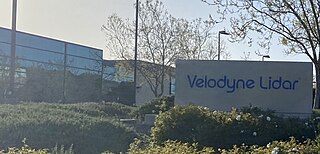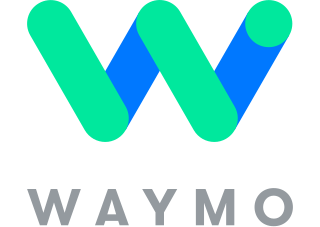
Velodyne Lidar is a Silicon Valley-based lidar technology company, headquartered in San Jose, California. It was spun off from Velodyne Acoustics in 2016. As of July 2020, the company has had about 300 customers. Velodyne Lidar ships sensors to mobility industry customers for testing and commercial use in autonomous vehicles, advanced driver assistance systems, mapping, robotics, infrastructure and smart city applications. In February 2023, the company merged with Ouster.

Waymo LLC, formerly known as the Google Self-Driving Car Project, is an American autonomous driving technology company headquartered in Mountain View, California. It is a subsidiary of Alphabet Inc, the parent company of Google.

Mobileye Global Inc. is an Israeli autonomous driving company. It is developing self-driving technologies and advanced driver-assistance systems (ADAS) including cameras, computer chips, and software. Mobileye was acquired by Intel in 2017 and went public again in 2022.
A robotaxi, also known as robo-taxi, self-driving taxi or driverless taxi, is an autonomous car operated for a ridesharing company.
Ottomotto LLC, d/b/a Otto, was an American self-driving technology company founded in January 2016 by Lior Ron and Anthony Levandowski.

Argo AI LLC was an autonomous driving technology company headquartered in Pittsburgh, Pennsylvania. The company was co-founded in 2016 by Bryan Salesky and Peter Rander, veterans of the Google and Uber automated driving programs. Argo AI was an independent company that built software, hardware, maps, and cloud-support infrastructure to power self-driving vehicles. Argo was mostly backed by Ford Motor Co. (2017) and the Volkswagen Group (2020).
Torc Robotics (Torc), an independent subsidiary of Daimler Truck, is an American autonomous truck company headquartered in Blacksburg, Virginia, with operations in Albuquerque, New Mexico; Austin, Texas; and Stuttgart, Germany. Torc is testing autonomous trucks in Virginia, New Mexico, and Texas and is taking a pure play approach to commercialization – focusing at first on one platform in one region.
aiMotive is an autonomous vehicle technology company. The company aims to work with automotive manufacturers and Tier1s to enable automated technologies. aiMotive describes its approach as "vision-first", a system that primarily relies on cameras and artificial intelligence to detect its surroundings. The technology is designed to be implemented by automobile manufacturers to create autonomous vehicles, which can operate in all conditions and locations. In September 2017, PSA Group teamed up with AImotive.

A self-driving truck, also known as an autonomous truck or robo-truck, is an application of self-driving technology aiming to create trucks that can operate without human input. Alongside light, medium, and heavy-duty trucks, many companies are developing self-driving technology in semi trucks to automate highway driving in the delivery process.
Drive.ai, a subsidiary of Apple Inc., is an American technology company headquartered in Mountain View, California that uses artificial intelligence to make self-driving systems for cars. It has demonstrated a vehicle driving autonomously with a safety driver only in the passenger seat. To date, the company has raised approximately $77 million in funding. Drive.ai's technology can be modified to turn a vehicle autonomous.

Guangzhou Xiaopeng Motors Technology Co., Ltd., doing business as XPeng Motors, commonly known as XPeng, is a Chinese electric vehicle manufacturer. The company is headquartered in Guangzhou, Guangdong, with offices in Mountain View, California, United States and Munich, Germany. XPeng stock is publicly traded on the New York Stock Exchange and the Hong Kong Stock Exchange.

Yandex self-driving car is an autonomous car project of the Russian-based technology company Yandex. The first driverless prototype launched in May 2017. As of 2018, functional service was launched in Russia with prototypes also being tested in Israel and the United States. In 2019, Yandex revealed autonomous delivery robots based on the same technology stack as the company's self-driving cars. Since 2020, autonomous robots have been delivering food, groceries and parcels in Russia and the United States. In 2020, the self-driving project was spun-off into a standalone company under the name of Yandex Self-Driving Group.
DeepMap, is a Palo Alto, California-based software company that develops high definition (HD) maps for self-driving vehicles.

Ouster, Inc. is an American lidar technology company headquartered in San Francisco, California. It builds high-resolution, digital 3D lidar sensors for use in autonomous vehicles, industrial, robotics, drones, mapping, defense, and security systems.
Aurora Innovation, Inc., doing business as Aurora, is a self-driving vehicle technology company based in Pittsburgh, Pennsylvania. Aurora has developed the Aurora Driver, a computer system that can be integrated into cars for autonomous driving. Aurora was co-founded by Chris Urmson, the former chief technology officer of Google/Alphabet Inc.'s self-driving team, which became known as Waymo, as well as by Sterling Anderson, former head of Tesla Autopilot, and Drew Bagnell, former head of Uber's autonomy and perception team.

Seoul Robotics is a software company based in Seoul, South Korea. The company was founded in 2017 by HanBin Lee. Seoul Robotics creates 3D vision software for LiDAR and other sensing technologies. Its software is used for applications in fields such as autonomous vehicles, advanced driver assistance systems, smart manufacturing, construction, logistics, and smart cities. Notable partners of Seoul Robotics include BMW, Volvo, Mercedes-Benz, Mando, and Qualcomm.
Plus is an American autonomous trucking technology company based in Cupertino, California. The company develops Level 4 autonomous trucking technology for commercial freight trucks. In 2019, the company completed the first cross-country driverless freight delivery in the U.S. The company's self-driving system began to be used commercially in 2021.
DeepRoute.ai is a self-driving technology company headquartered in Shenzhen and Fremont, California and is focused on advancing urban logistics and popularizing robotaxis.

Austin Russell is an American entrepreneur, founder and CEO of Luminar Technologies. Luminar specializes in lidar and machine perception technologies, mainly used in autonomous cars. Luminar went public in December 2020, making him a billionaire at the age of 25. He is negotiating a contract to become the majority owner of Forbes since May 2023 according to Fortune Magazine.
Aeva Technologies, Inc. is a publicly traded American corporation specializing in sensing hardware and perception software, including LiDAR, headquartered in Mountain View, California. Aeva makes sensing and perception tools for vehicular automation, metrology, and industrial automation.









